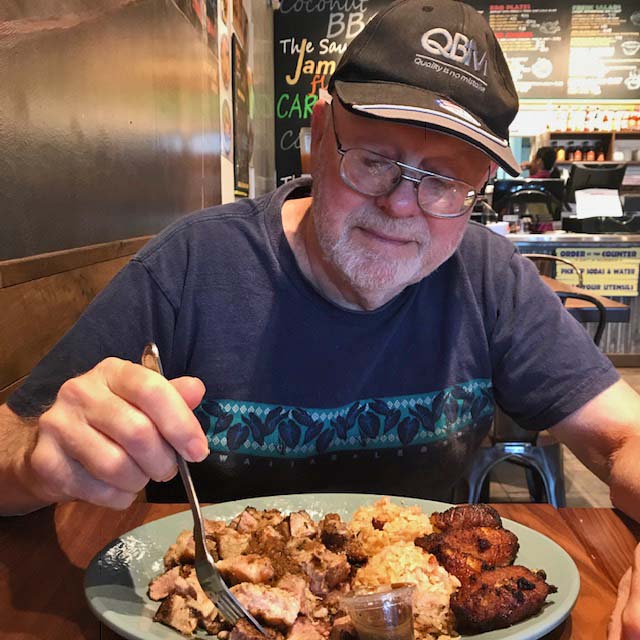by Hoyt Nelson

“Heat” is an acquired taste. The more you eat, the more you increase your tolerance, and eventual love for it. “Spicy” is a relative term so it’s difficult to tell a restaurant your “personal” comfort level since there is such a wide range of heat available in restaurants and such a wide range of tolerances between people. If your server can give you a choice you probably should ask for “mild” (unless you know different) and request their house hot sauce on the side. Sometimes, they will offer one of the Crystal or McIlhenny variants (which I find too sour for my taste), various small Mexican bottles or none at all. Such is the case at the otherwise great restaurant “Habana Cuba” on S. First St. in San Jose. In this case, I bring my own small bottle of Sambal (I always have a bottle in the fridge).
Chile peppers are one of a class of foods like salt, sugar and vinegar that we add to improve flavor of our food (and in some cases, aid in its preservation). Before the late 1800s, when canned foods were developed for the French army, there were few other ways to preserve food except for salting and drying. We get our word “salary” from a stipend of salt given to Roman soldiers. If he was a good soldier, he was said to be “worth his salt”. There is also evidence that the Romans concocted a sauce nearly identical to our Asian fish sauce.
The heat sensation you feel from peppers is caused by capsaicin, which is a colorless, odorless, oily chemical found in peppers. Capsaicin also has some nice medicinal properties to it as an anti fungal and anti-microbial agent, so it can act as a preservative. Capsaicin is able to kill prostate, lung cancer and some leukemia cells.
A scale of hotness (as defined by the amount of sugar water required to stop your brain from thinking it is burned) was developed by chemist Wilbur Scoville. (Plain water or tea usually won’t remove the hotness). Some examples of hotness levels on the Scoville scale are:
§ Sweet Bell Peppers: 0 Units
§ Jalapeno: 2500-8000 units
§ “Standard” Pepper Spray: 25,000-2,000,000 units
§ Cayenne: 30,000-50,000 units
§ Red Savina Habanero: 350,000-577,000 units
§ Bear Mace: 2,000,000-2,500,000 units
§ Law Enforcement Grade Pepper Spray: 5,000,000-5,300,000 units
§ Pure Capsaicin: 15,000,000-16,000,000 units
Chili peppers were probably cultivated in South or Central America as far back as 7500 BC and at least as far back as 2000 BCin India. By 40 AD, the Romans gobbled up peppers in 80% of their recipes, but the only pepper they knew was the black and white pepper corns we now sprinkle out of our pepper shakers.

meal at Back-a-Yard
Back to restaurant talk. One of my favorite restaurants is Back-A-Yard Caribbean grill in San Jose on N Market (conveniently across the street from a big parking garage for which the restaurant will validate your parking). It’s Caribbean, which means they use a really hot homemade jerk sauce, but they make the basic protein fairly mild and then supply you with small container of hot sauce on the side. The large dinners all have chicken, pork, goat, salmon or tofu, and come with delicious rice (beans and sauce mixed in) and fried plantains. The protein and plantains have just the right amount of char. They also serve BBQ, but for me, it’s all about the jerk. There are interesting fresh fruit drinks, beer and great meat patties – all at quite reasonable prices. There also locations in Menlo Park and on Capitol Ave. in San Jose, but I think the atmosphere and food is better at N Market.
We went to Thaibodia in Santa Clara a few years ago and found it OK, but not spectacular. There is a new location at 2200 S Bascom Ave. which we recently decided to check out. It’s a bit small, but nicely decorated. The menu is large and we appreciated the addition of Cambodian dishes, which is just now becoming more common in San Jose area. We usually order Thai food mediumspicy, but for some reason we ordered it mild this time. Lucky us. It turns out that mildhere was a little hotter than mediumto our taste. Our choices of Pan Fried Pork Dumplings, Pad Khee Mow (like Pad Thai) and Char Thuk Chhou Aim were all very tasty, but a bit intense so we had to order some plain rice to tone it down a notch. We wobbled out quite full and still had a heavy doggy bag, so we didn’t mind a little extra cost.
We returned to Thaibodia a few weeks after our first encounter. This time, we found it a lot less spicy than before – perhaps because of customer complaints. I can now recommend the place as long as you exercise some caution. We actually added some of their available spice choices to reach our happy level. (Most Thai and Vietnamese places put a tray of 4 or 5 spice choices on all tables.) Indian restaurants frequently ask how hot you prefer your dish, but they don’t often supply sauces on the side (except the optional three small dishes for your samosa or pakora appetizers). Peruvian places supply a small dish of ground pepper, which you should treat with respect and start with a very small amount. I usually don’t care how hot the side sauces are because you can always regulate how much to put on your food. More important to me is the flavor.



